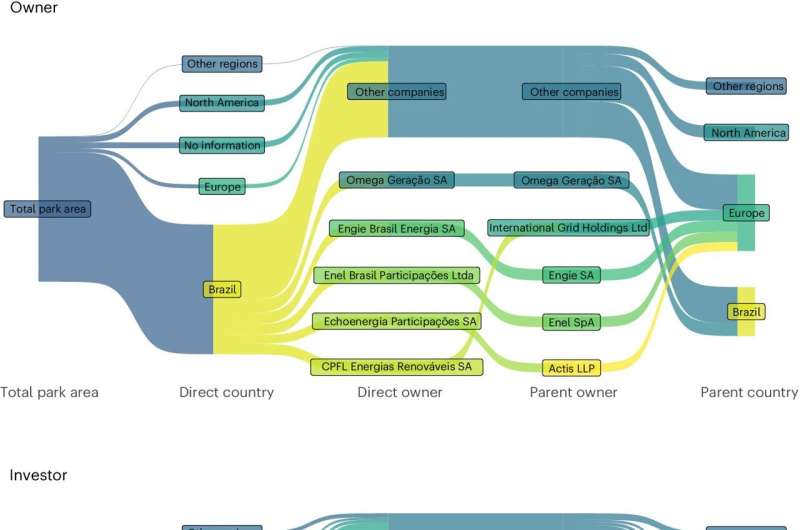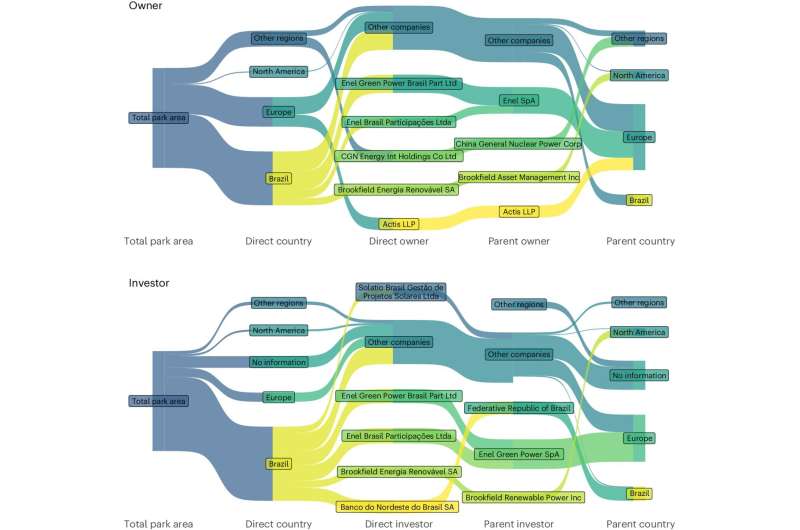This article has been reviewed according to Science X's editorial process and policies. Editors have highlighted the following attributes while ensuring the content's credibility:
fact-checked
peer-reviewed publication
trusted source
proofread
'Green grabbing' of Brazilian public and common lands a threat, says study

The privatization of land for renewable energy infrastructure in Brazil is leading to the appropriation of once-public and common lands by large international corporations because of poor oversight and lack of transparency, finds a new study involving UCL researchers.
The study, published in Nature Sustainability, found that land privatization is the dominant means for solar and wind companies to secure land for their power generation infrastructure, which includes the transfer of control of formerly public and common lands to often international companies.
In the years between 2011and 2021, wind power in Brazil grew from 1.2% of its power generation capacity to 11.4%, and solar power grew from 0.1% to 2.6%, with plans for significant growth in place over the next several decades. While the transition from fossil fuels to renewable energy reduces carbon emissions, wind parks and solar photovoltaic parks require a significant land footprint.
The researchers combined databases of geographic data with ownership and investment information, and digital land registries from 2000 through 2021. They found that wind parks take up a total of about 2,148 square kilometers and solar parks take up about 102 square kilometers in Brazil.
However, they found that international investors, primarily from Europe, claimed a 78% stake in wind parks and 96% share of solar assets. While on paper Brazilian entities own 89% of wind parks, the majority (68%) are subsidiaries of internationally controlled companies, particularly from Italy and France.

Most of the land that these companies build their energy infrastructure on is private property. However, there is a growing concern that the privatization process is stimulated by the expansion of renewable energies and acquired by dispossessing local residents.
A significant portion of wind parks have been built on legally dubious ground, including 28% that only rely on environmental registries without legal property titles, and 7% that are built on public common land.
Co-author Dr. Nadia Ameli (UCL Bartlett School of Environment, Energy and Resources) said, "Our work highlights the importance of striking a balance between sustainable energy development and the protection of public land and commons. Privatization with poor oversight and little transparency is being used to appropriate and transfer land from traditional communities to large international corporations, despite great land tenure insecurity."
This kind of appropriation is common in Brazil because of historical inequities in land ownership, regulatory gaps and weak governance. The phenomenon of "land grabbing" is well documented across Brazil, commonly for agricultural purposes like creating large cattle ranches and soybean farms.
It has led to environmental degradation and numerous conflicts over land ownership between Brazil's government, farmers and ranchers, and the country's traditional and indigenous population.
The researchers are concerned that the trend will continue as "green grabbing," which uses the need for clean and renewable energy as a justification for the further appropriation of public and common lands.
Lead author, Dr. Michael Klingler of Boku University, said, "The land issue is central to driving effective climate action and promoting 'just' low-carbon energy pathways. The necessity for the energy transition must not be questioned, but rather the way in which these projects are implemented.
"The collaboration with affected rural communities, NGOs and scientists in the Brazilian state of Bahia showed that traditional and marginalized population groups are confronted with 'new' land conflicts due to the expansion of renewable energies. However, these are increasingly being legitimized by the climate change mitigation imperative."
More information: Michael Klingler et al, Large-scale green grabbing for wind and solar photovoltaic development in Brazil, Nature Sustainability (2024). DOI: 10.1038/s41893-024-01346-2


















